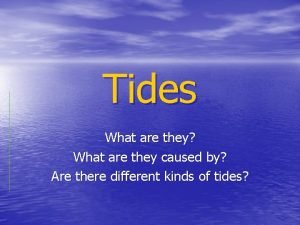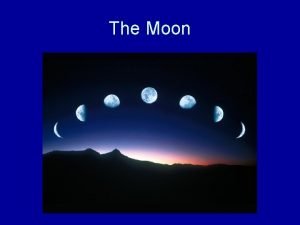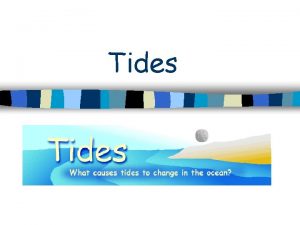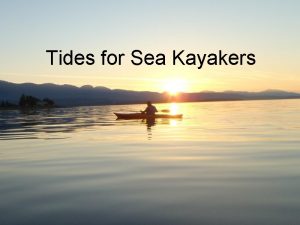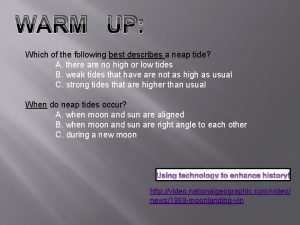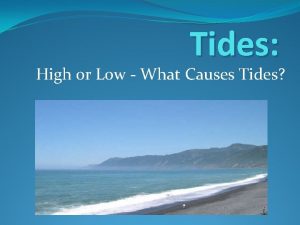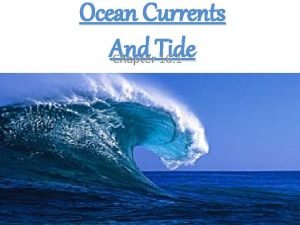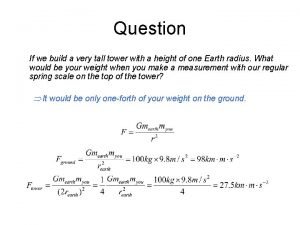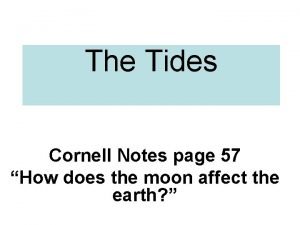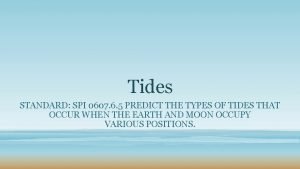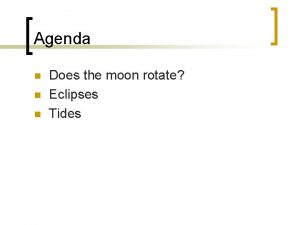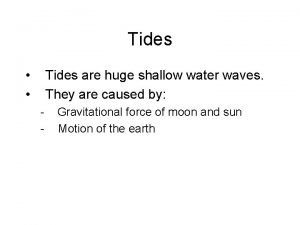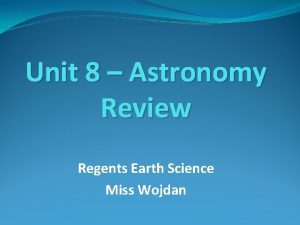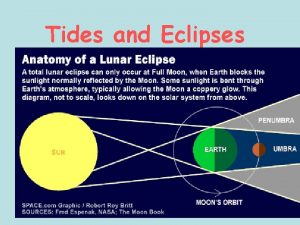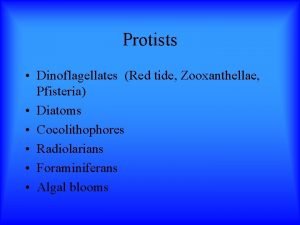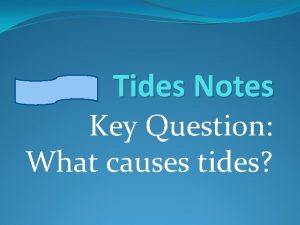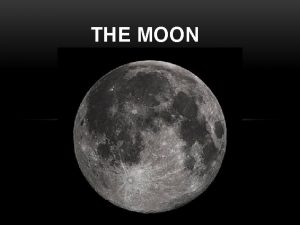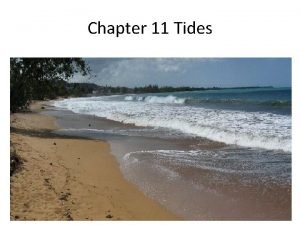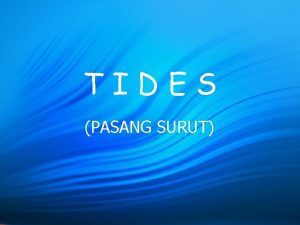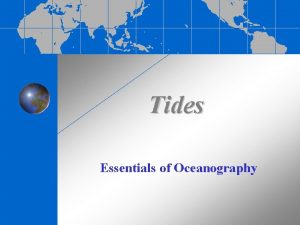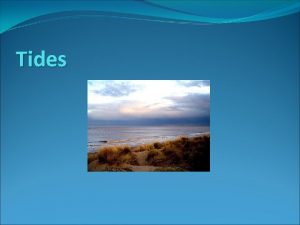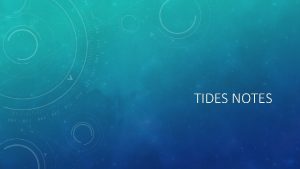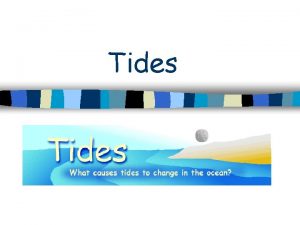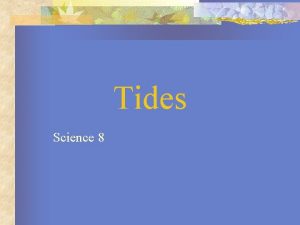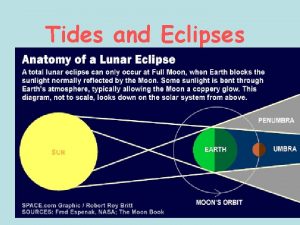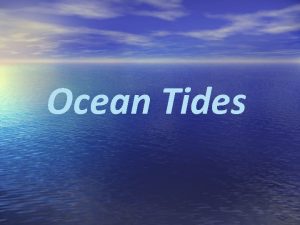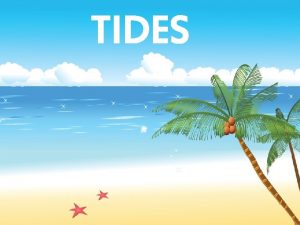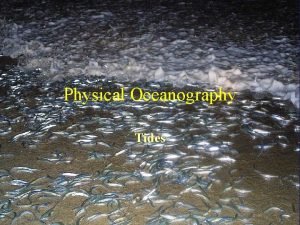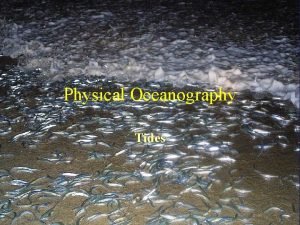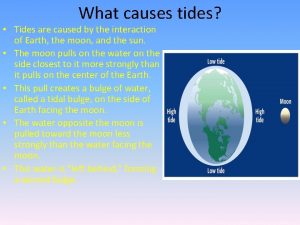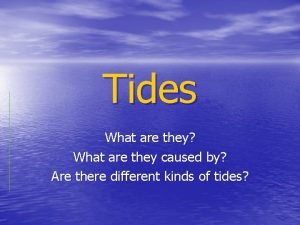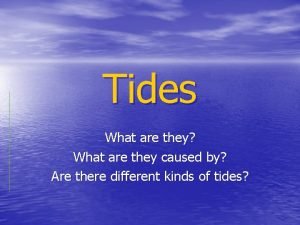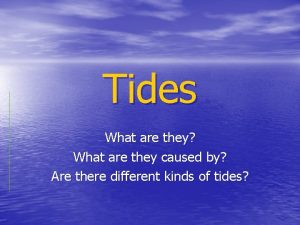Tides What are they What are they caused

































- Slides: 33

Tides What are they? What are they caused by? Are there different kinds of tides?

• Those of you who have spent some time on the beach have probably noticed that the water level of the ocean does not stay the same all day long. Although waves continually wash the shore, the actual water level changes as the day passes.

• It rises for a period of hours until it reaches its highest level, and then it begins to fall, or recede, to its lowest level. This rise and fall of the ocean is known as the tide. Its highest and lowest levels are, of course called high and low tides.

High Tide Low Tide

Tides – What are they? • Tides are daily changes in the level of ocean water. • They are the periodic rise and fall of the water level in the oceans and other large bodies of water. • I wonder how often this periodic rise and fall happens each day?

What causes tides? What moves ocean water? • Wind • Earthquakes • Plate tectonics • The dominant force that moves ocean water is the gravitational forces from both the sun and the moon.

The Lure of the Moon • The relationship between the phases of the moon and the tides was discovered more than 2, 000 years ago! • People of the time knew the moon had something to do with the tides, but they couldn’t explain why.

Sir Isaac Newton to the Rescue! • Newton’s Universal Gravitation theory helped to explain how the gravity of the moon (and the sun) were related to tides.

What causes tides? • The gravity of the moon pulls on everything on the Earth. • The moon’s gravitational pull on liquids is much more noticeable than on solids. • Why? Because liquids move more easily than solids.


What causes tides? • How often tides occur and the difference in tidal levels depend on the position of the moon as it revolves around the Earth. • The moon’s pull is strongest on the part of the Earth directly facing the moon.

High Tide • The part of the ocean directly facing the moon, bulges towards the moon. • There is a corresponding bulge on the opposite side of the Earth. • These bulges are called high tide.

Low Tide • When high tides occur, water is drawn away from the area between the high tides, which causes low tides to occur.

How often is there a change in tides? Try to figure it out. . . • High tides happen on opposite sides of the Earth. • The Earth rotates once on its axis every 24 hours. • How many high tides would any one place in the ocean experience each day?

Answer • The periodic rise and fall of the water level in the oceans and other large bodies of water happens. . . • Four times each day!

What effect does the sun have on tides? • The sun is much larger than the moon. • The sun is farther away from the Earth than the moon. Q: Which one (the sun or the moon) do you think has a bigger effect on tides? A: The moon, just because it is closer.

Tidal Variations • Tidal Range = the difference in levels of ocean water at high tide and low tide. • Tidal ranges vary greatly due to the combined forces of the sun and the moon on the Earth • It all depends on the position of the Earth, moon, and the sun in space.

Spring Tide ( STRONG tides) • A tide with a large tidal range that occurs two times a month (new moon and full moon) • Sun, Earth, and the moon are aligned (Straight)

Spring Tide • The highest high tides The lowest low tides.

Neap Tides (WEAK Tides) • A tide of minimum range that occurs during the first and third quarters of the moon • The sun, Earth, and moon form a 90 degree angle

Neap Tides • Not very high tides • Not very Low tides




End of Section • Write a Question and Summary SUMMARY : Tides are caused by the gravitational pull of the moon. High tides are on the sides where water bulges and are directly facing the moon and across. There are two special tides Spring and Neap. Questions: What are the strongest tides? And what phase of the moon?

Weird Science! • The moon also creates tides in our atmosphere • They are called lunar winds • They can be detected by studying slight periodic fluctuations in weather patters • Very strange, indeed!

Review Q: What are tides? • Tide = the periodic rise and fall of the water level in the oceans and other large bodies of water. Q: What is the dominant force that moves ocean water? • The gravitational forces from both the sun and the moon.

Review (cont’d) Q: Where is the moon’s pull is strongest on the Earth? • The moon’s pull is strongest on the part of the Earth directly facing the moon.

Review (cont’d) Q: Which one (the sun or the moon) has a bigger effect on tides? • The moon

Review (cont’d) Q: What is the difference in levels of ocean water at high tide and low tide called? • Tidal Range Q: Tidal ranges vary greatly due to the combined forces of the _____ and the ____ on the Earth • Sun, moon

Review (cont’d) Q: How are the sun, Earth, and moon situated in space so that we experience a spring tide? • Sun, Earth, and the moon are aligned

Review (cont’d) Q: How are the sun, Earth, and moon situated in space so that we experience a neap tide? • The sun, Earth, and moon form a 90 degree angle

www. youtube. com/watch? v=KFYf_it 461 s
 What are tides and how are they caused
What are tides and how are they caused What causes the phases of the moon
What causes the phases of the moon Spring tide and neap tide
Spring tide and neap tide Smkvqmuzwv4 -site:youtube.com
Smkvqmuzwv4 -site:youtube.com Antigentest åre
Antigentest åre Five actors were competing for the leading role in the play
Five actors were competing for the leading role in the play Diurnal tides
Diurnal tides Eclipses and tides lesson 3
Eclipses and tides lesson 3 Tides
Tides Which of the following best describes temperature brainpop
Which of the following best describes temperature brainpop Semidiurnal tide
Semidiurnal tide When does a spring tide occur
When does a spring tide occur Shifting tides timeline and map
Shifting tides timeline and map Neap and spring tides
Neap and spring tides Spring and neap tides
Spring and neap tides Spring tides
Spring tides Home.hiwaay.net/ krcool/astro/moon/moon tides/
Home.hiwaay.net/ krcool/astro/moon/moon tides/ Spi tides
Spi tides 142 cooper river drive
142 cooper river drive What are tides?
What are tides? Mooloolaba tides
Mooloolaba tides How does the sun affect tides
How does the sun affect tides Cleaning the tides of san diego and tijuana
Cleaning the tides of san diego and tijuana Tides
Tides He can turn the tide and calm the angry sea
He can turn the tide and calm the angry sea Ocean tides observed at coastal locations
Ocean tides observed at coastal locations What type of tide occurs at a lunar and solar eclipse?
What type of tide occurs at a lunar and solar eclipse? Shifting tides timeline and map
Shifting tides timeline and map Tide
Tide Pfisteria
Pfisteria Tides notes
Tides notes Moons pattern
Moons pattern Tides
Tides Tides adalah
Tides adalah
